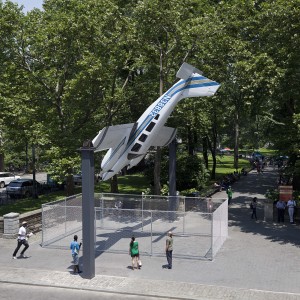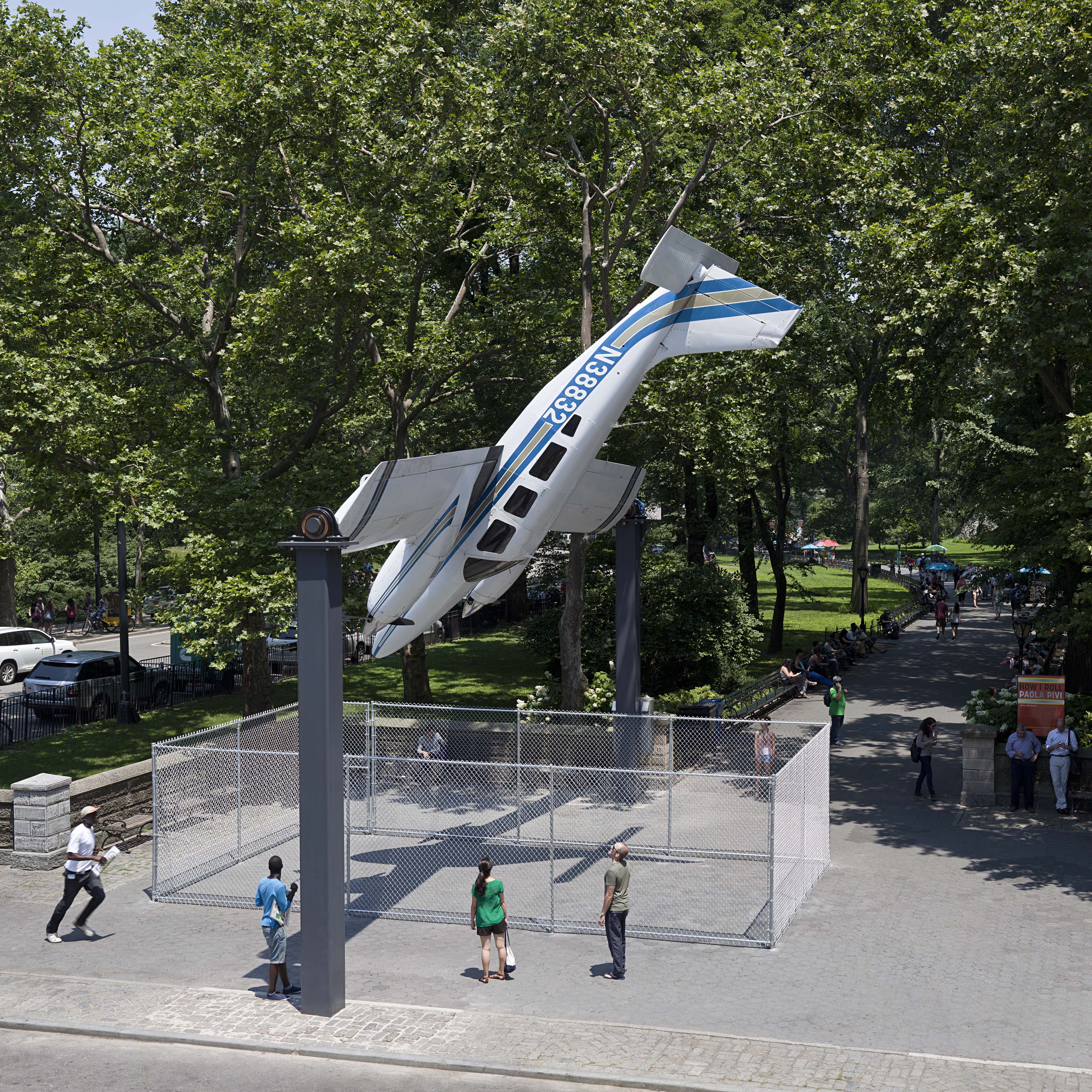 New York is, famously, a city whose seen-it-all citizens are above doing double takes when celebrities walk by. Neither, as it turns out, do some of them raise an eyebrow at a six-passenger, 35-foot-long twin-engine airplane spinning above their heads. How I Roll, which has been somersaulting above Fifth Avenue at 60th Street for a few weeks now, is a monumental kinetic sculpture by the Italian artist Paola Pivi and, jaded New Yorkers notwithstanding, it’s remarkable.
New York is, famously, a city whose seen-it-all citizens are above doing double takes when celebrities walk by. Neither, as it turns out, do some of them raise an eyebrow at a six-passenger, 35-foot-long twin-engine airplane spinning above their heads. How I Roll, which has been somersaulting above Fifth Avenue at 60th Street for a few weeks now, is a monumental kinetic sculpture by the Italian artist Paola Pivi and, jaded New Yorkers notwithstanding, it’s remarkable.
The piece was commissioned by the Public Art Fund, and financed by several generous private donations, including my own. About two years ago, Public Art Fund curator Nicholas Baume and I created a small selection committee to commission a new artwork from a living artist. Joining us on the committee were independent curator Alison Gingeras and Tom Eccles, Executive Director of the Center for Curatorial Studies at Bard College and a former director of Public Art Fund. When Ms. Pivi’s name came up, we all knew we had a winner: she has never had a proper gallery show in New York and is mostly unknown in the U.S. In Europe, she has enjoyed considerable success for a unique style of conceptual art with a twist of absurdity: a leopard walking across a room of cappuccino cups, an alligator in a sea of shaving cream, a zebra standing in snow-covered mountains. Her decision to place a spinning airplane above Doris C. Freedman Plaza wasn’t altogether surprising, given her longstanding interest in large vehicles: she won early recognition in 1997 when she tipped over an 18-wheeler semi-trailer truck, but she has also posed helicopters upside down and leaned fighter jets against walls.
The time-and-money logistics of putting her airplane in place in New York were arduous and lengthy, and there were moments when it looked like the project would never happen. But Ms. Pivi has a magic touch: all the way from Anchorage, Alaska, where she’s lived for several years, she manages to convince people to realize her dreams. After more than two years of planning and engineering and the clearing of much red tape, the piece is finally installed for its two- month run (the piece was finished so late that it arrived four months into its six- month permit). Well, better late than never—I’m convinced it’s the most daring public artwork New York has witnessed in a very long time.
Shortly before she returned to Anchorage, I caught up with Ms. Pivi over lunch at Bergdorf’s. From the seventh-floor café’s windows, we had a bird’s-eye view of her extraordinary piece, and, after remarking that she loves the way a huge twirling plane that looks like it might easily fit in at an amusement park can also function as contemporary art, she recalled how she scraped together financing for her early projects, in the late 1990s. “My first major outdoor piece was a tractor-trailer tipped over on its side,” she said. Her day job as an aerobics instructor wasn’t sufficient to pay her art production bills. “I had to borrow the money from my uncle and my landlord. Fortunately the piece was a success and I managed to pay them back.”
In 2003, she got a show in New York—really, more of a micro-show, in the tiny Chelsea storefront that served as Maurizio Cattelan, Massimiliano Gioni and Ali Subotnick’s Wrong Gallery. The display was short-lived. “I showed only a single piece, one of my bunches of pearls, but it was too heavy for the wall, and the landlord became afraid of the weight because it was hanging on the door to a boiler room, so they took it down after a single week.”
The idea for the spinning airplane came, she said, from “a vision I had.” As for its title, that came from her husband, Karma, a poet and musician who trained as a Tibetan monk. Ms. Pivi insists that “art has no specific meaning” and that she’s “not trying to say more than what you see,” but how, in a city like New York where everyone is always on the go in all manner of vehicle, could I not read into her artwork my own question, “where are we really going?”
“I am not commenting on New York,” she said. “I am commenting on man and machine, time and beauty. The piece is about transcending limits.”
Isn’t it also about the failure of progress ? “No. … The making of the artwork is huge progress, a big move forward.”
While she wouldn’t divulge to me what inspired the suspended airplane, Ms. Pivi did agree that, as a civilization, we are not exactly moving forward. “Western society overall is indeed going in the wrong direction,” she said. “For example, they don’t stop trashing the ocean. Think about all the trash; where I live in Alaska we pay only $65 a month for garbage removal, but that’s not the real price. The real price would take into account the impact this has on the planet. This garbage will stay for years; no one thinks to calculate the real long-term cost this has to the planet.”
But if art has no defined meaning, and her piece, as she sees it, is not a commentary on our world, then what, I wanted to know, is she really up to? “What I’m doing is manipulating things that people think can’t be manipulated,” she told me. “This in itself is an extra power. An airplane is meant to fly, and this airplane [though decommissioned] is flying too, but in its own way, and forever. In the workshop, when we lifted it for the first time and we spun it around, we felt the plane was happy, the airplane was happy to be back in the air.”
And then our interview ended, not because my curiosity had been satisfied, or because we’d finished our lunch, but because while I contemplated the happily spinning plane, all other questions evaporated.

Thanks for your article – I was wondering about that spinning airplane
I remember her upside helicopter in Salzburg…genius
Tim Smith
Well written. I am compelled to act. Peter Carini
thanks PC, sadly it broke after a monthy, but its getting fixed…
remember Bariloche?
You must think you’re pretty awesome for sponsoring this.